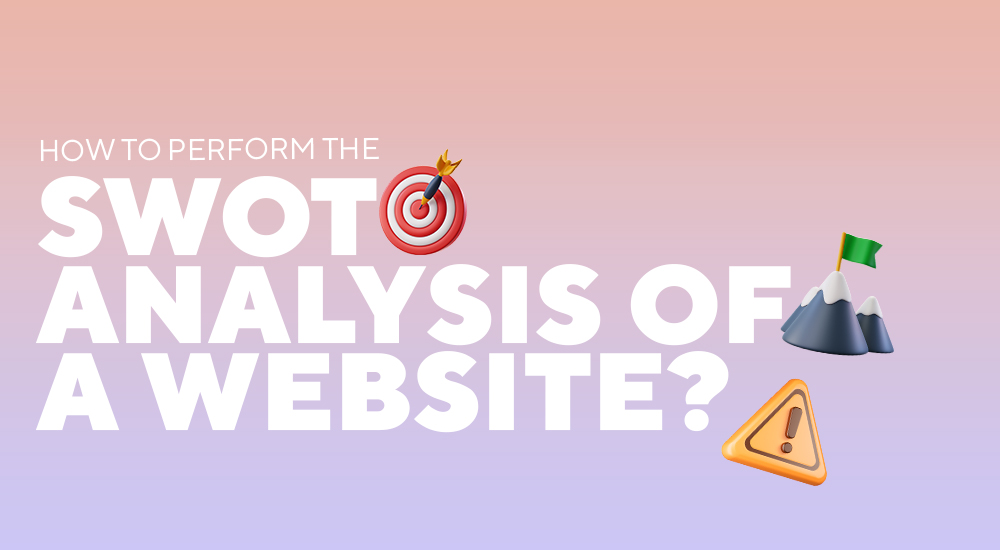Let's Talk
We would love to hear from you. Want to know more about our services or have any questions? Say Hi!
How To Perform The Swot Analysis Of A Website?

With the evolution of technology at a rapid pace in this age of digitisation, staying ahead of the competition is truly a challenge for any business. Businesses are investing heavily in technology, marketing and advertising and making tireless efforts to ensure that their brand is recognised and accepted in the market. But only a handful of them gain success in acing this challenge, the reason, wrong fundamentals and weak base. What do we mean by that, they either don’t have done a proper analysis of their business and are under or overutilizing their resources.
Worry not, we have got a solution for this problem, the website SWOT analysis, yes the same analysis we do to determine our own potential, can be applied with slight modifications for the business website. Without further ado, let’s understand the mechanics of this approach and how can we benefit from it in the long run.
How to perform a website SWOT analysis?
A website in general, involves 3 components, Content Creation, Web designing & SEO or analytics. For a proper SWOT analysis, a few things should be kept handy:
- Website analytics data of last quarter.
- Customer journey mapping data
- Competition analysis data
To do a SWOT analysis, first make a table with 4 headings namely, Strengths, Weaknesses, Opportunities & Threats. Now divide, all 4 headings in two factors, external and internal. Your table should look something like this.
| Strengths | Weaknesses | |||
| Internal | ||||
| External | ||||
| Opportunities | Threats | |||
| Internal | ||||
| External |
Each parameter of SWOT needs to be clearly defined with proper examples if needed, let’s take a look at some of the sample questions that need answering in each parameter.
Strengths
This is the main area for any business, it should clearly communicate the strengths of the website and why it stands out.
- What is the main USP of your website?
- Why have we made our website like this?
- What is our website’s current conversion rate?
- What are the most visited pages of our website and why?
- Which aspects of our website, do the users like and why?
The answer to the above questions can be bifurcated into internal and external. A few examples of both include:
Internal: Better Website UI, UX; Easier navigation; Unique products; Hassle-free checkout process among others.
External: Great ratings & reviews; good quality backlinks; good word of mouth and influencer impact.
Weaknesses
The main intention to show weakness is to have a look at the potential drawbacks and strategise on how to fix them. Care must be taken on not to be overly critical and be on the verge of self-sabotage.
Weakness is a critical part and generally involves some common terms that need to be analyzed carefully.
Internal: Page loading time, complex navigation, corrupt pages, troublesome layout, numerous bugs and outdated content.
External: Bad social media strategy, negative publicity, trolling and no backlinks.
Opportunities
These often come with a time limit, they need to be seized at the right moment before our competitors take advantage of them. They are somewhat tricky to identify, but largely focus on a few factors:
- Are there any gaps in the current market?
- Can we fill those with existing technology?
- In which areas can we beat our competitors
- Can we be bench setter in any area?
Internal: Hiring plans for the web team, content team & SEO team.
External: Tapping into the current digital marketing trends, Implementing the latest technology in web design, UI/UX services and simplifying website interface.
Opportunities for websites are sometimes a double-edged sword, it may be possible that exploring a particular area might lead to some undesired results, for example, things like UI, UX improvement have an angle of perspective involved, it may be possible that an improved design might not be an instant connect with the audience, in such cases things like re-designing, customer feedback are extremely helpful.
The whole point of analyzing opportunities is to be optimistic and have an open mindset when it comes to exploring new areas. The greater the feedback and ideation, the higher the chances of success. After all, a great website is one which listens and aligns itself to the customer’s needs while being innovative at the same time.
Threats
Often when it comes to threats, businesses fear a lot, they appear like inevitable dangers that will ruin the entire business or website with no solution. The good news is, the impact of threats to a great extent are just myths or just pure analysis paralysis. A great part of threats especially internal ones are totally within our control, and even the external ones depend on how we react. Threats will be present no matter what we do and how perfectly we do things, but their damage can be minimised with proper action in a timely manner.
Internal: Weak security of the website( using HTTP version instead of HTTPS), website crashing, internal leaks by employees, outdated content, website not ranking higher in search results.
External: Bad reviews by customers or disgruntled employees, the introduction of new laws and policies, cyber-attacks, stolen credentials.
Now take, for example, an internal threat like weak security, this is easily resolvable with migration to the HTTPS version. The external one like new laws and policies, is also manageable, as the changed laws are for every other website too in the same sector and they also need to respond to these challenges.
In a nutshell, the impact of threat largely depends on how we react and frame our website according to those challenges. But over analysis or fear of impending doom is exaggerated. Threats must be used as stepping stones to counter and make the website more robust, reliable and responsive to evolving challenges.
What’s next?
The biggest question after completing a website SWOT analysis is what to do next and what benefits will be available to the business. The answer lies in the simple fact, that implementation is the key. Preparing and executing a proper roadmap based on SWOT analysis results will go a long way in proving the customers with an experience that they will cherish in times to come.
As for benefits some important ones that will definitely make an impact are as follows:
- Makes the website more attractive and user-friendly.
- Significantly higher chances of lead generation and conversion.
- More sales and publicity.
- A benchmark for others to follow, on how good a website can be.
- Standing out and ahead of the competition
- Capturing the moment and giving the users something that will resonate with them for long.
Few Closing Thoughts
This website’s SWOT analysis list is by no means an exhaustive one, every business in its domain, has a unique set of strengths, weaknesses, opportunities and threats. It must adapt to those while performing a SWOT analysis. But one thing is clear, by implementing the results of a SWOT analysis, a business website is sure to attract more traffic and have better growth prospects. The brand image will receive a significant boost and the website will be more versatile in adapting to the evolving changes be it on the technology front or the business side.
A bonus tip while doing this exercise, is to seek the advice of an independent branding agency or website development agency to get rid of the bias in some situations. An outsider’s perspective also greatly helps in getting diverse viewpoints and helping us prepare better for the situations. It also aids us in adhering to the latest formats and structure of the analysis, and how to interpret the results in a more meaningful way.
If this write-up, piqued your interest and you want to hop on the website SWOT analysis bandwagon, consider contacting us to get a detailed blueprint and strategy on how to execute this properly.
With over two decades of expertise and happy & satisfied clientele across the globe, the experts at Litmus Branding will make sure your business stays ahead of the competition, always.


